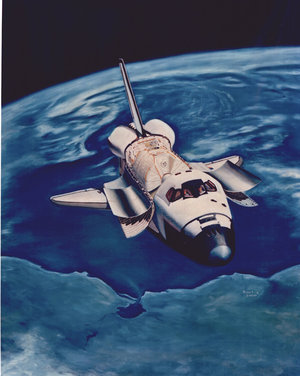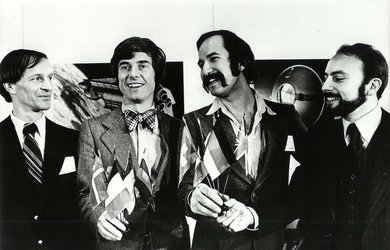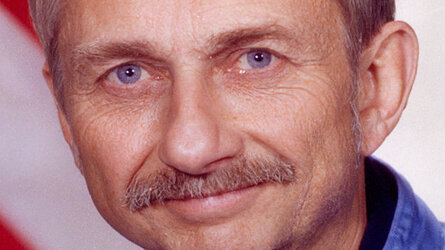Owen Garriott: STS-9 Mission Specialist
NASA astronaut Owen Garriott spent 10 days in space as a Mission Specialist on the STS-9/Spacelab-1 mission in November 1983.

Dr Owen K. Garriott was one of the first six scientist-astronauts selected by NASA in 1965, previously he was Associate Professor in the Department of Electrical Engineering, Stanford University. Spacelab-1 was his second spaceflight. His first flight on Skylab 3 in 1973 set a new world record for duration of nearly 60 days, more than double the previous record. Sadly, Dr Garriott passed away in April 2019, aged 88.
Extracts from interview by K. Rusnak, 2000, JSC Oral History
The whole mission of Spacelab-1 was oriented towards making clear that Spacelab was useful for the whole range of scientific disciplines. So we had about six different disciplines represented, so very interdisciplinary, which is, well, my interest is interdisciplinary work. So not only a lot of biomedical work, but also astronomy, fluid physics, materials processing, atmospheric sciences, all were represented with different experiments.
There were multi-disciplinary experiments in the area of life sciences. Vestibular experiments, a whole array of those, and blood-drawing. But we didn’t have quite the full range of facilities that we had on Skylab, so to some degree they were different. For vestibular, there was a rotating dome. There were other kinds of visual experiments to be done.
In fluid physics, we had a whole rack of equipment that enabled you to inject liquids, shake them and rotate them, combine them, stretch them, do all sorts of things to look at the small forces associated with the surface tension and even smaller forces that are associated with fluids that you can not well demonstrate or measure here in a 1G environment. So a whole rack of equipment oriented toward a variety of fluid physics experiments.
An adjacent double rack associated with materials processing, some of which you would have furnaces in which you would insert rods that heated up to very high temperatures and then solidified very slowly. Others in which you focused light on a crystal and melted it and then allowed it to solidify more carefully.
We then had a large overhead window in which we had to look outside for experiments related to stellar astronomy and air glow, with sophisticated spectrometers to look at the air glow layer and see just what wavelength it was coming back. So you could see this line comes from hydrogen or oxygen and nitrogen, more likely, to see what the wavelength and intensity of those lines associated with the atoms and molecules might be.
Comparing training and preparation for a Space Shuttle mission and that of Skylab, actually they were somewhat similar. There were fewer disciplines represented on Skylab, and so we did not have to travel as far to talk with the principal investigators on Skylab. But on Spacelab, the investigators were all over the world, because this was an international flight. We had the first foreign national to fly with us on Spacelab 1, Ulf Merbold. A lot of the fluid physics rack and much of the material science was designed and built in Europe. The principal investigators were in Europe.
So we were continually traveling all over the world to see the investigators in their home laboratories where they had the instruments similar to what we were going to be doing in space, and to learn what it was they were looking for, to understand better the objectives of their experiments.
Also, the Japanese had a very interesting experiment. It had to do with electron beam emission. So we had to take a number of trips to Japan, as well as them coming to the US to explore the conduct of their experiments. I feel so fortunate to have had the chance to work in all of these different disciplines with the real world’s experts, and to learn from them.
On Skylab, my commander was Alan Bean. On my second flight, John Young, who was the commander of Spacelab-1, is not an Alan Bean. He’s motivated differently, different personality, standard sort of a prototypical test pilot. He was a little concerned about, bringing in the first foreign national. How well is that going to work?
It turned out it worked extremely well, for which I give John Young a lot of credit. I really enjoyed having John as the commander of our flight. And I think after we came back he had no better friend on board our flight than Ulf Merbold. They still often talk. Whenever Ulf comes back, I think they get together for dinner. So we got along extremely well.
On Spacelab-1, one of our first experiments had to do with a rotating dome, which would be taking a picture of your eye as it sort of twisted a little bit. That camera, the apparatus to which it was mounted, broke very early in the flight. And to get these pictures properly required thousands and thousands of frames of photographs on a very nice format camera, special camera.
After the frame apparatus broke, all of this film and camera was sitting there without any particular use, so John Young helped find a use for that. He took the camera and all of these rolls of film up to the flight deck. I think he spent a major fraction of the flight taking pictures out that left-hand window with this nice format camera. He was very willing to let anybody else come up there and have that seat and take the pictures of the things that you thought were interesting or valuable and so forth.
John really jumped in and assisted in the conduct of the science, and I think before flight there was some little concern about that, that whether or not a standard prototypical test pilot would enjoy and participate. But we all really enjoyed having him on board. He did his share, as did the rest of us. I worked with Byron Lichtenberg on my flight. He is still a very close friend of mine. We were working on two shifts there, so three of us together, then three on the other shift, although we overlapped quite a bit. So we would often still get together. Good bunch of people to fly with.
It was a little hard to tell when you came back (if the flight was successful), but when we came down and landed, of course, like a glider, I remember going in the van, being picked up by George Abbey and he said, “Well, the science community is very happy.” So that was the clue we had. But when George was willing to tell us that, I was very pleased.














